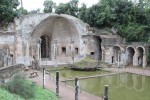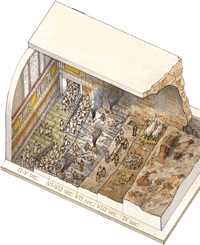Athenaeum of Hadrian dig completed
 Three years ago archaeologists surveying Piazza Venezia in the center of Rome for a much-needed third subway line found the remains of an athenaeum built by the emperor Hadrian in the second century A.D. The brick manufacturers’ stamps confirmed that the arts center was built in 123 A.D., 12 years earlier than first suggested based on ancient documentary sources.
Three years ago archaeologists surveying Piazza Venezia in the center of Rome for a much-needed third subway line found the remains of an athenaeum built by the emperor Hadrian in the second century A.D. The brick manufacturers’ stamps confirmed that the arts center was built in 123 A.D., 12 years earlier than first suggested based on ancient documentary sources. It had three rectangular rooms in which poets, philosophers, authors and rhetoricians recited their work and taught lessons to audiences of up to 900 people. Characteristic of Hadrian’s particular interests in architecture, it had an unusual arched roof. Hadrian loved him some domed roofs. According to Cassius Dio (Roman History, Book 69, Chapter 4), Hadrian had Trajan’s favorite architect Apollodorus of Damascus exiled and executed because he had once insulted Hadrian’s penchant for domes.
Once when Trajan was consulting him on some point about the buildings he had said to Hadrian, who had interrupted with some remark: “Be off, and draw your gourds. You don’t understand any of these matters.”
 The gourd in question was apparently the dome of the Serapeum at Hadrian’s Villa in Tivoli which Hadrian was in the process of designing at the time.
The gourd in question was apparently the dome of the Serapeum at Hadrian’s Villa in Tivoli which Hadrian was in the process of designing at the time.Apollodorus’ disdain notwithstanding, Hadrian combined his love of architecture with his love of art and Hellenophilic tendencies to create the athenaeum which he had built right next to the Apollodorus-designed Forum of Trajan. Hadrian also wrote poetry in both Latin and Greek, so the auditorium was a perfect storm of the emperor’s interests.
 Archaeological evidence indicates the space was used as an auditorium through the 5th century A.D., long after Hadrian’s death and well into the Christian period. Its marble began to be quarried around the sixth century. At the same time, metal ingots and the remains of furnaces found from the 6th and 7th centuries suggest it may have been used a mint in the Byzantine era for the production of bronze coins. It was also apparently used as a necropolis in the late 7th century, and following the trend of an increasingly depopulated, ruralized Rome, as a livestock barn in the 8th.
Archaeological evidence indicates the space was used as an auditorium through the 5th century A.D., long after Hadrian’s death and well into the Christian period. Its marble began to be quarried around the sixth century. At the same time, metal ingots and the remains of furnaces found from the 6th and 7th centuries suggest it may have been used a mint in the Byzantine era for the production of bronze coins. It was also apparently used as a necropolis in the late 7th century, and following the trend of an increasingly depopulated, ruralized Rome, as a livestock barn in the 8th.In the 9th century the roof collapsed during an earthquake in 848 A.D. After that, new structures were built on top of it, including a hospital in the 16th century. A microcosm of millennia of Roman life, t’s a major find, the most important in 70 years, some archaeologists believe.
So now that the excavation is complete, what about the Metro line? The problem isn’t the subway tunnel itself which will be 80 feet underground to avoid the layers and layers of Roman history. It’s the subway stop, which of course has to come up to modern ground level, causing all the headaches. The final decision has yet to be made, but transit authorities are hoping to work with archaeologists to build the exit along an ancient sewer line. The remains of the athenaeum will be right next to the stop, protected but still visible by tourists and riders.
